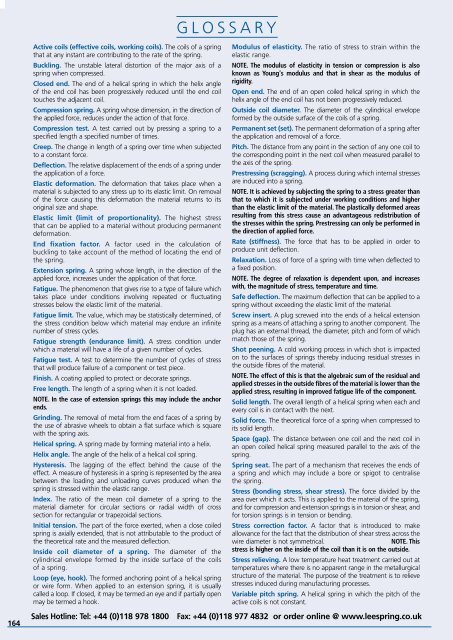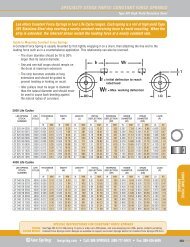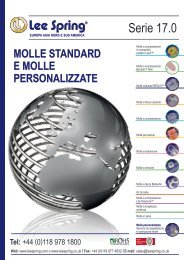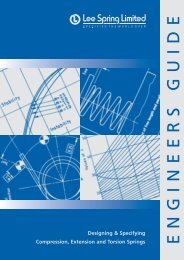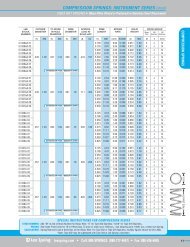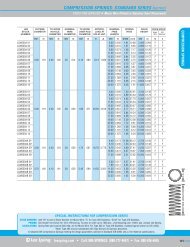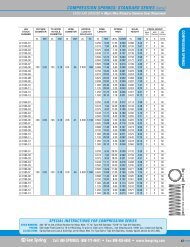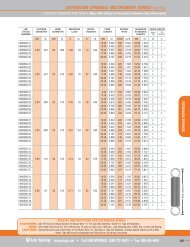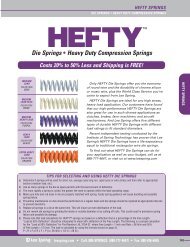SPRING CA T ALOGUE - Lee Spring
SPRING CA T ALOGUE - Lee Spring
SPRING CA T ALOGUE - Lee Spring
You also want an ePaper? Increase the reach of your titles
YUMPU automatically turns print PDFs into web optimized ePapers that Google loves.
164Active coils (effective coils, working coils). The coils of a springthat at any instant are contributing to the rate of the spring.Buckling. The unstable lateral distortion of the major axis of aspring when compressed.Closed end. The end of a helical spring in which the helix angleof the end coil has been progressively reduced until the end coiltouches the adjacent coil.Compression spring. A spring whose dimension, in the direction ofthe applied force, reduces under the action of that force.Compression test. A test carried out by pressing a spring to aspecified length a specified number of times.Creep. The change in length of a spring over time when subjectedto a constant force.Deflection. The relative displacement of the ends of a spring underthe application of a force.Elastic deformation. The deformation that takes place when amaterial is subjected to any stress up to its elastic limit. On removalof the force causing this deformation the material returns to itsoriginal size and shape.Elastic limit (limit of proportionality). The highest stressthat can be applied to a material without producing permanentdeformation.End fixation factor. A factor used in the calculation ofbuckling to take account of the method of locating the end ofthe spring.Extension spring. A spring whose length, in the direction of theapplied force, increases under the application of that force.Fatigue. The phenomenon that gives rise to a type of failure whichtakes place under conditions involving repeated or fluctuatingstresses below the elastic limit of the material.Fatigue limit. The value, which may be statistically determined, ofthe stress condition below which material may endure an infinitenumber of stress cycles.Fatigue strength (endurance limit). A stress condition underwhich a material will have a life of a given number of cycles.Fatigue test. A test to determine the number of cycles of stressthat will produce failure of a component or test piece.Finish. A coating applied to protect or decorate springs.Free length. The length of a spring when it is not loaded.NOTE. In the case of extension springs this may include the anchorends.Grinding. The removal of metal from the end faces of a spring bythe use of abrasive wheels to obtain a flat surface which is squarewith the spring axis.Helical spring. A spring made by forming material into a helix.Helix angle. The angle of the helix of a helical coil spring.Hysteresis. The lagging of the effect behind the cause of theeffect. A measure of hysteresis in a spring is represented by the areabetween the loading and unloading curves produced when thespring is stressed within the elastic range.Index. The ratio of the mean coil diameter of a spring to thematerial diameter for circular sections or radial width of crosssection for rectangular or trapezoidal sections.Initial tension. The part of the force exerted, when a close coiledspring is axially extended, that is not attributable to the product ofthe theoretical rate and the measured deflection.Inside coil diameter of a spring. The diameter of thecylindrical envelope formed by the inside surface of the coilsof a spring.Loop (eye, hook). The formed anchoring point of a helical springor wire form. When applied to an extension spring, it is usuallycalled a loop. If closed, it may be termed an eye and if partially openmay be termed a hook.GLOSSARYModulus of elasticity. The ratio of stress to strain within theelastic range.NOTE. The modulus of elasticity in tension or compression is alsoknown as Young's modulus and that in shear as the modulus ofrigidity.Open end. The end of an open coiled helical spring in which thehelix angle of the end coil has not been progressively reduced.Outside coil diameter. The diameter of the cylindrical envelopeformed by the outside surface of the coils of a spring.Permanent set (set). The permanent deformation of a spring afterthe application and removal of a force.Pitch. The distance from any point in the section of any one coil tothe corresponding point in the next coil when measured parallel tothe axis of the spring.Prestressing (scragging). A process during which internal stressesare induced into a spring.NOTE. It is achieved by subjecting the spring to a stress greater thanthat to which it is subjected under working conditions and higherthan the elastic limit of the material. The plastically deformed areasresulting from this stress cause an advantageous redistribution ofthe stresses within the spring. Prestressing can only be performed inthe direction of applied force.Rate (stiffness). The force that has to be applied in order toproduce unit deflection.Relaxation. Loss of force of a spring with time when deflected toa fixed position.NOTE. The degree of relaxation is dependent upon, and increaseswith, the magnitude of stress, temperature and time.Safe deflection. The maximum deflection that can be applied to aspring without exceeding the elastic limit of the material.Screw insert. A plug screwed into the ends of a helical extensionspring as a means of attaching a spring to another component. Theplug has an external thread, the diameter, pitch and form of whichmatch those of the spring.Shot peening. A cold working process in which shot is impactedon to the surfaces of springs thereby inducing residual stresses inthe outside fibres of the material.NOTE. The effect of this is that the algebraic sum of the residual andapplied stresses in the outside fibres of the material is lower than theapplied stress, resulting in improved fatigue life of the component.Solid length. The overall length of a helical spring when each andevery coil is in contact with the next.Solid force. The theoretical force of a spring when compressed toits solid length.Space (gap). The distance between one coil and the next coil inan open coiled helical spring measured parallel to the axis of thespring.<strong>Spring</strong> seat. The part of a mechanism that receives the ends ofa spring and which may include a bore or spigot to centralisethe spring.Stress (bonding stress, shear stress). The force divided by thearea over which it acts. This is applied to the material of the spring,and for compression and extension springs is in torsion or shear, andfor torsion springs is in tension or bending.Stress correction factor. A factor that is introduced to makeallowance for the fact that the distribution of shear stress across thewire diameter is not symmetrical.NOTE. Thisstress is higher on the inside of the coil than it is on the outside.Stress relieving. A low temperature heat treatment carried out attemperatures where there is no apparent range in the metallurgicalstructure of the material. The purpose of the treatment is to relievestresses induced during manufacturing processes.Variable pitch spring. A helical spring in which the pitch of theactive coils is not constant.Sales Hotline: Tel: +44 (0)118 978 1800 Fax: +44 (0)118 977 4832 or order online @ www.leespring.co.uk


